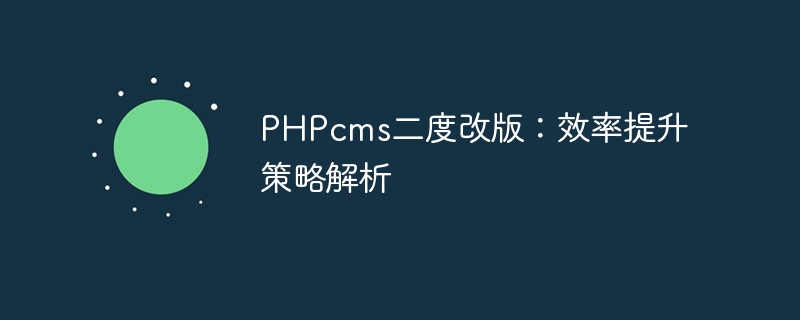

PHPcms second revision: analysis of efficiency improvement strategies
With the continuous development of Internet technology, website management and maintenance are becoming more and more important. , and using CMS (content management system) to build websites has become a very common choice. As a mainstream open source CMS system, PHPcms is widely used in various website development. This article will discuss the theme of the second revision of PHPcms, focusing on analyzing how to improve system efficiency and achieve a better user experience by optimizing and improving code.
When carrying out the second revision of PHPcms, optimizing database query is a very critical link. Avoiding frequent database queries can effectively reduce system response time. For example, you can use caching technology to cache the results of some frequent queries to reduce the number of accesses to the database.
// 查询文章列表示例
function getArticleList($category_id) {
$cache_key = 'article_list_' . $category_id;
$article_list = get_cache($cache_key);
if (!$article_list) { // 缓存不存在,从数据库查询
$article_list = db_query("SELECT * FROM articles WHERE category_id = $category_id");
set_cache($cache_key, $article_list, 3600); // 缓存结果,有效期1小时
}
return $article_list;
}Static resources such as CSS and JavaScript files will take up more bandwidth and loading time during the page loading process. By using compression technology, you can reduce file size and speed up resource loading.
// 使用gzip压缩静态资源
function compress_static_resource($file) {
ob_start("ob_gzhandler");
readfile($file);
ob_end_flush();
}When there are a large number of images in the web page, you can use lazy image loading technology to delay loading of images and reduce page loading. time to improve user experience.
<!-- 图片懒加载示例 -->
<img src="placeholder.jpg" data-src="real-image.jpg" class="lazyload" alt="PHPcms second revision: analysis of efficiency improvement strategies" >
<script>
document.addEventListener("DOMContentLoaded", function() {
var lazyloadImages = document.querySelectorAll('.lazyload');
lazyloadImages.forEach(function(img) {
img.setAttribute('src', img.getAttribute('data-src'));
});
});
</script>Storing static resources such as images, CSS, JavaScript and other files on CDN can effectively share the server load, reduce network latency, and speed up page loading.
<!-- 使用CDN示例 --> <link rel="stylesheet" href="https://cdn.example.com/style.css"> <script src="https://cdn.example.com/script.js"></script>
During the second revision of PHPcms, it is necessary to consider the system's performance under high concurrency conditions. stability. Writing concurrency-safe code can avoid data race and resource contention problems caused by concurrency.
// 示例:使用互斥锁确保并发安全
$lock = fopen("lock.txt", "w+");
if (flock($lock, LOCK_EX)) {
// 进行并发安全的操作
flock($lock, LOCK_UN);
}
fclose($lock);By monitoring system performance, performance bottlenecks can be discovered and resolved in a timely manner. You can use tools such as XDebug, New Relic, etc. to analyze system performance and optimize code based on monitoring data.
// XDebug性能分析示例
xdebug_start_trace('trace_file');
// 代码执行
xdebug_stop_trace();Through the above code optimization and efficiency improvement strategies, we can achieve better results during the second revision of PHPcms. It can not only improve system performance and reduce resource consumption, but also improve user experience to better meet user needs. In future website development, you may wish to try the above strategies to improve the overall performance and user experience of the website.
I hope the strategies and code examples provided in this article can be helpful to you. You are welcome to make corresponding adjustments and optimizations according to your needs in actual development. I hope your PHPcms second revision will be smoother and your efficiency will be greatly improved!
The above is the detailed content of PHPcms second revision: analysis of efficiency improvement strategies. For more information, please follow other related articles on the PHP Chinese website!